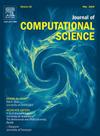Allen-Cahn方程的能量耗散守恒物理通知神经网络
IF 3.7
3区 计算机科学
Q2 COMPUTER SCIENCE, INTERDISCIPLINARY APPLICATIONS
引用次数: 0
摘要
基于物理信息神经网络(PINN),研究了具有常迁移率和退化迁移率、多项式和对数能量泛函、确定性和随机初始函数以及一维、二维和三维平流项的Allen-Cahn方程的数值解。为了提高PINN的学习能力,我们将Allen-Cahn方程的能量耗散特性作为惩罚项加入到网络的损失函数中。为了方便随机首字母的学习过程,我们利用傅立叶级数展开对初始随机条件进行连续模拟。本文还结合了传统数值分析中的自适应方法,提高了所提pin网络的有效性。数值结果表明离散能量持续下降,同时也揭示了相分离和亚稳态等现象。本文章由计算机程序翻译,如有差异,请以英文原文为准。
Energy dissipation preserving physics informed neural network for Allen–Cahn equations
This paper investigates a numerical solution of Allen–Cahn equation with constant and degenerate mobility, with polynomial and logarithmic energy functionals, with deterministic and random initial functions, and with advective term in one, two, and three spatial dimensions, based on the physics-informed neural network (PINN). To improve the learning capacity of the PINN, we incorporate the energy dissipation property of the Allen–Cahn equation as a penalty term into the loss function of the network. To facilitate the learning process of random initials, we employ a continuous analogue of the initial random condition by utilizing the Fourier series expansion. Adaptive methods from traditional numerical analysis are also integrated to enhance the effectiveness of the proposed PINN. Numerical results indicate a consistent decrease in the discrete energy, while also revealing phenomena such as phase separation and metastability.
求助全文
通过发布文献求助,成功后即可免费获取论文全文。
去求助
来源期刊

Journal of Computational Science
COMPUTER SCIENCE, INTERDISCIPLINARY APPLICATIONS-COMPUTER SCIENCE, THEORY & METHODS
CiteScore
5.50
自引率
3.00%
发文量
227
审稿时长
41 days
期刊介绍:
Computational Science is a rapidly growing multi- and interdisciplinary field that uses advanced computing and data analysis to understand and solve complex problems. It has reached a level of predictive capability that now firmly complements the traditional pillars of experimentation and theory.
The recent advances in experimental techniques such as detectors, on-line sensor networks and high-resolution imaging techniques, have opened up new windows into physical and biological processes at many levels of detail. The resulting data explosion allows for detailed data driven modeling and simulation.
This new discipline in science combines computational thinking, modern computational methods, devices and collateral technologies to address problems far beyond the scope of traditional numerical methods.
Computational science typically unifies three distinct elements:
• Modeling, Algorithms and Simulations (e.g. numerical and non-numerical, discrete and continuous);
• Software developed to solve science (e.g., biological, physical, and social), engineering, medicine, and humanities problems;
• Computer and information science that develops and optimizes the advanced system hardware, software, networking, and data management components (e.g. problem solving environments).
 求助内容:
求助内容: 应助结果提醒方式:
应助结果提醒方式:


